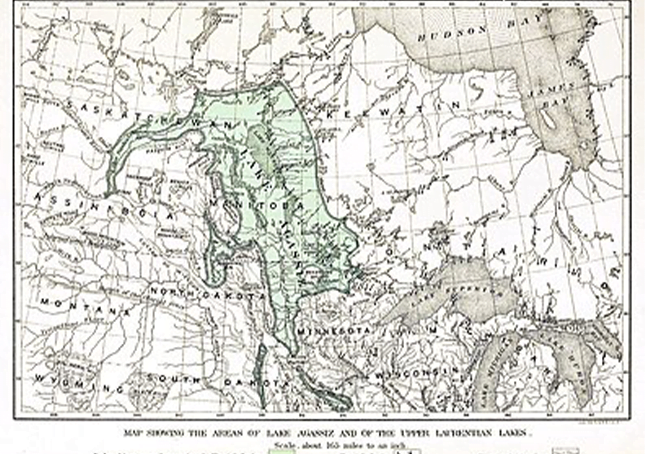Lake Agassiz

Lake Agassiz was a very large glacial lake in central North America. Fed by glacial meltwater at the end of the last glacial period, its area was larger than all of the modern Great Lakes combined though its mean depth was not as great as that of many major lakes today.
First postulated in 1823 by William H. Keating, it was named by Warren Upham in 1879 after Louis Agassiz, when Upham recognized that the lake was formed by glacial action.
During the last Ice Age, northern North America was covered by an ice sheet, which alternately advanced and retreated with variations in the climate. This continental ice sheet formed during the period now known as the Wisconsin glaciation, and covered much of central North America between 30,000 and 10,000 years ago. As the ice sheet disintegrated, its meltwaters created an immense proglacial lake.
Around 13,000 years ago, this lake came to cover much of what are now Manitoba, northwestern Ontario, northern Minnesota, eastern North Dakota, and Saskatchewan. At its greatest extent, it may have covered as much as 440,000 km2 (170,000 sq mi), larger than any currently existing lake in the world (including the Caspian Sea) and approximately the area of the Black Sea.
At times the lake drained south through the Traverse Gap into Glacial River Warren (parent to the Minnesota River, a tributary of the Mississippi River), east through Lake Kelvin (modern Lake Nipigon) to what is now Lake Superior, and northwest through the Clearwater Spillway to the Mackenzie River System and the Arctic Ocean about 13,000 years ago.
The ice returned to the south for a time, but as it again retreated north of the present Canada–United States border around 10,000 years ago, Lake Agassiz refilled. The last major shift in drainage occurred around 8,200 years ago. The melting of remaining Hudson Bay ice caused Lake Agassiz to drain nearly completely. This final drainage of Lake Agassiz has been associated with an estimated 0.8 to 2.8 m (2.6 to 9.2 ft) rise in global sea levels.
Lake Agassiz’s major drainage reorganization events were of such magnitudes that they had significant impact on climate, sea level and possibly early human civilization. The lake’s enormous freshwater release into the Arctic Ocean has been postulated to have disrupted oceanic circulation and caused temporary cooling. The draining of 13,000 years ago may be the cause of the Younger Dryas stadial.
Although disputed, the draining at 9,900–10,000 years ago may be the cause of the 8,200 yr climate event. A recent study by Turney and Brown links the 8,500-years ago drainage to the expansion of agriculture from east to west across Europe; they suggest that this may also account for various flood myths of prehistoric cultures, including the Biblical flood narrative.
